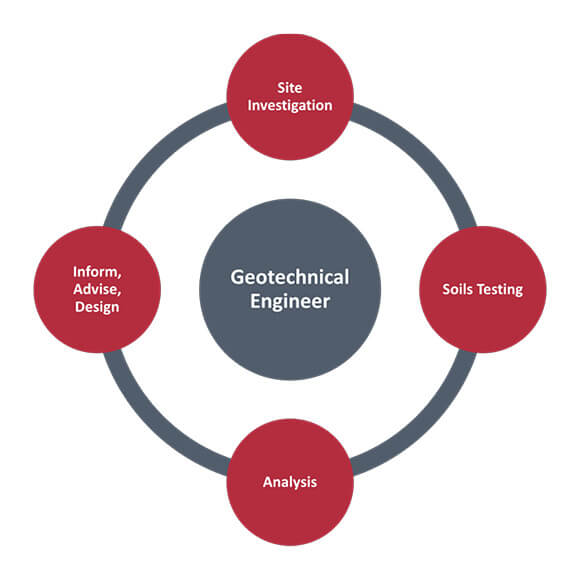Geotheta Things To Know Before You Get This
Geotheta Things To Know Before You Get This
Blog Article
The Geotheta Diaries
Table of ContentsThe smart Trick of Geotheta That Nobody is DiscussingGetting The Geotheta To WorkGetting The Geotheta To WorkThe 6-Minute Rule for GeothetaGeotheta for Beginners

They conduct site investigations, gather examples, execute laboratory tests, and evaluate data to examine the suitability of the ground for construction tasks - Engineer of Record. Based on their findings, geotechnical designers supply referrals for structure style, incline stability, maintaining frameworks, and mitigation of geotechnical risks. They team up with various other specialists, such as engineers, structural engineers, and construction teams, to ensure that geotechnical considerations are incorporated right into the general job design and application
By evaluating the behavior and residential properties of soil and rock, they can identify potential geotechnical threats such as landslides, soil settlement, or incline instability. Their proficiency aids stop failures or accidents that could jeopardize lives and building. Right here are some comprehensive duties and duties of a geotechnical designer: Site Examination: Geotechnical engineers conduct site examinations to gather information on subsurface problems.
They translate the data to comprehend the buildings and behavior of the soil and rock, including their stamina, leaks in the structure, compaction features, and groundwater problems. Geotechnical Evaluation and Design: Geotechnical engineers analyze the information accumulated throughout site examinations to analyze the stability and suitability of the website for construction projects. They do geotechnical computations and modeling to assess variables such as birthing ability, settlement, slope security, lateral earth pressures, and groundwater circulation.
Geotheta Can Be Fun For Anyone
Foundation Layout: Geotechnical designers play a critical role in making foundations that can securely support the desired framework. They evaluate the soil problems and tons demands to determine the suitable structure type, such as superficial structures (e.g., grounds), deep foundations (e.g (https://ameblo.jp/geotheta/entry-12862281966.html)., piles), or specialized methods like dirt enhancement. They consider aspects such as negotiation restrictions, bearing capacity, and soil-structure communication to create optimum structure styles
They evaluate construction plans, screen website tasks, and conduct area evaluations to validate that the style referrals are adhered to. If unanticipated geotechnical problems develop, they examine the scenario and provide suggestions for remediation or changes to the design. Danger Evaluation and Mitigation: Geotechnical engineers assess geotechnical dangers and risks connected with the project site, such as landslides, liquefaction, or soil erosion.

Collaboration and Communication: Geotechnical engineers function closely with other specialists associated with a job, such as architects, architectural engineers, and building groups. Reliable interaction and cooperation are vital to integrate geotechnical considerations right into the general project style and construction procedure. Geotechnical designers provide technological experience, response queries, and make sure that geotechnical requirements are met.
Everything about Geotheta
Here are Get More Information some types of geotechnical engineers: Foundation Engineer: Foundation designers concentrate on designing and examining structures for frameworks. They assess the dirt problems, load demands, and website features to establish one of the most ideal structure kind and style, such as shallow foundations, deep structures, or specialized strategies like stack foundations.
They assess the aspects influencing slope security, such as soil buildings, groundwater problems, and slope geometry, and establish methods to protect against incline failings and reduce dangers. Earthquake Engineer: Earthquake engineers specialize in evaluating and developing structures to stand up to seismic pressures. They examine the seismic threat of a site, review soil liquefaction possibility, and create seismic layout requirements to guarantee the safety and strength of structures throughout earthquakes.
They perform area testing, accumulate examples, and analyze the accumulated data to characterize the soil residential properties, geologic formations, and groundwater conditions at a website. Geotechnical Instrumentation Engineer: Geotechnical instrumentation designers concentrate on tracking and measuring the habits of soil, rock, and frameworks. They install and keep instrumentation systems that monitor variables such as soil settlement, groundwater levels, incline movements, and architectural displacements to examine performance and supply very early cautions of potential issues.
The Single Strategy To Use For Geotheta
They perform tests such as triaxial tests, consolidation tests, straight shear tests, and permeability examinations to collect information for geotechnical evaluation and layout. Geosynthetics Designer: Geosynthetics designers focus on the layout and application of geosynthetic products, such as geotextiles, geogrids, and geomembranes. They utilize these materials to enhance soil stability, strengthen inclines, provide drainage services, and control erosion.
They have a tendency to be investigative individuals, which implies they're intellectual, introspective, and inquisitive. They wonder, methodical, reasonable, logical, and rational. Some of them are also social, indicating they're kind, generous, cooperative, person, caring, useful, understanding, skillful, and pleasant. Does this sound like you? Take our totally free profession test to discover if geotechnical designer is just one of your top career matches.
In the workplace atmosphere, geotechnical engineers make use of specialized software program tools to execute estimations, produce layouts, and evaluate data. They prepare records, evaluation project specifications, connect with clients and staff member, and coordinate project tasks. The office setting gives a helpful atmosphere for research, evaluation, and collaboration with various other experts involved in the job.
Not known Facts About Geotheta
They regularly go to task sites to conduct website investigations, evaluate geotechnical problems, and collect data for analysis. These visits entail traveling to various areas, sometimes in remote or challenging surfaces. Geotechnical engineers may do soil sampling, conduct tests, and screen building and construction activities to guarantee that the geotechnical facets of the task are being implemented properly.
Geotechnical designers likewise work in specialized geotechnical laboratories. Geotechnical laboratory designers function thoroughly in these atmospheres, dealing with testing equipment, running tools, and taping information.
Report this page